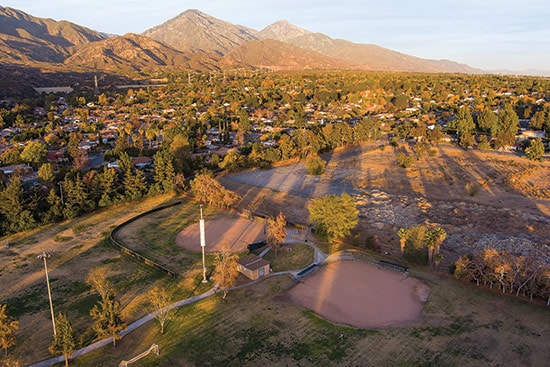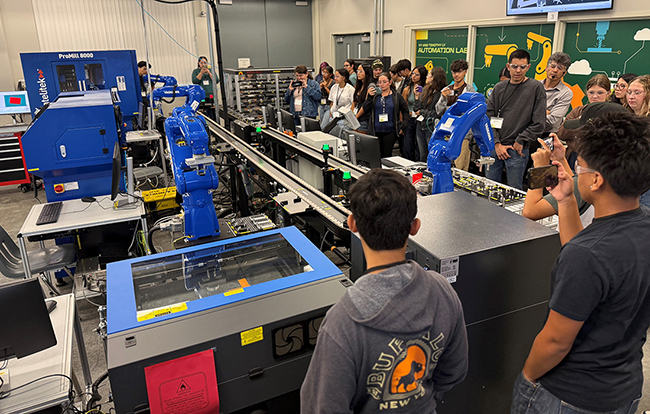Proposed changes to sports park met by city, community resistance

by Steven Felschundneff | steven@claremont-courier.com
The builder behind the proposed development of the La Puerta Middle School site in north Claremont has released new plans for a redesign of the La Puerta Sports Park and a proposal to build a sports complex for girls at Cahuilla Park.
According to a news release from Trumark, the new sports park plan is a direct result of public feedback the company has received, including a Youth Sports Committee meeting on December 2.
In its initial proposal, Trumark had asked to carve out a one-acre strip of the sports park to bolster the size of the school site. In return, the company offered to refurbish the park including the softball diamonds. However, because the overall area of park would be reduced, the soccer fields would end up being smaller than regulation size, meaning that teams with players over the age of 13 would have to compete elsewhere.
Under the company’s new plan, the
In a letter dated September 1 from Eric Norris, a contract planner working on Claremont’s behalf, addressed to Trumark executive Eric Nelson, the city states its desire for the sports park to “be left in its existing size and configuration, which are the result of significant planning, discussion, and adjustments to best meet the needs of the sports leagues.”
The letter also states that due to the city’s long-term lease with Claremont Unified School District for “a specific acreage for the existing La Puerta Sports Park,” any change to the size of the park would require both entities to renegotiate the terms in the lease.
“We will be discussing internally the most appropriate time to bring this item to the city council which would need to agree to the change in the lease,” the city stated in the letter. That renegotiation would need to happen either before or concurrently with consideration of the project.
The city also objected to a plan to grade the park, stating that the turf has been built up over years and at great expense and is a highly desired soccer field as a result. Other issues included public amenities and parking.
The city notes that lights at the sports park are specifically regulated by municipal code for soccer practice only and are limited to certain hours and days. This point of contention could be solved by the proposal to move the softball diamonds.
Community Development Director Brad Johnson told the COURIER on Tuesday that the city’s position has not changed regarding keeping La Puerta Sports Park at its current size, in part because of feedback he has received from the community. Mr. Johnson said Trumark has not submitted any changes to its original application so the design that debuted at the Youth Sports Committee meeting is not official.
The next step for Trumark will be presenting the proposed development plans at the various committees and commissions, including planning and architectural commissions. Through that process, commissioners would be able to approve or reject any part of the proposal including the changes to the park. Trumark’s proposal will begin its journey through the commission process in late spring or early summer.
Mr. Johnson said it can take years for a development like this to get from the initial application to breaking ground.
“The public gets anxious and wants constant feedback,” Mr. Johnson said. “But it’s really early in the process.”
Residents adjacent to the property have expressed concerns during past meetings about altering the park and Trumark’s plan to build 65 homes, with nine accessory dwelling units on a roughly 11-acre parcel.
A group calling itself “Preserve Claremont” has called for the city to reject any change to La Puerta’s zoning so that it will remain a public space.
Jeff Marshall, professor of geological sciences and regenerative studies at Cal Poly Pomona, would like to see the land used for a community environmental education facility and Tongva cultural center.
“I support the efforts of Preserve Claremont to halt the building of housing and to preserve this land as open space for the city. Presently, this Claremont Unified School District land is slated for construction of a high-density luxury housing development, inconsistent with the surrounding neighborhood and adjacent open space of the La Puerta Sports Park and Thompson Creek Trail,” Mr. Marshall said.
A rumor has been circulating that Claremont real estate developer Roger Wheeler and his wife Mary gave the La Puerta property to the school district for “public education use.” Mr. Wheeler’s son, architect Paul Wheeler, told the COURIER that his parents received fair market value for the land which at the time sold for around $10,000 an acre.
However, the younger Mr. Wheeler, who lives on Indian Hill adjacent to the property, is no fan of Trumark’s proposal.
“It’s an affront to all the hard work that has been put into the planning we have done here since 1888,” Mr. Wheeler said.
He cited the density of the development, including parcels less than half the size of the surrounding neighborhood which is zoned for 13,000-square-foot lots. He also described an established “rhythm and pattern” of developments in Claremont that complement existing neighborhoods. For example, Roger Wheeler, who died in 2008, developed 30 acres just north of La Puerta that includes large lots with covenants protecting each home’s view of the mountains.
“Somebody’s being greedy. Either the school district, the developer or both,” Mr. Wheeler said.
The property, located at 2475 N. Forbes Avenue, is currently a fenced field that CUSD mows occasionally to keep the weeds in check. The district demolished the former school buildings in June of 2018.
Given the extreme shortage of housing in California, it may be inevitable that some type of housing will be built at the La Puerta site at some point. After press time on Thursday the city hosted a community meeting to discuss an update to the city’s housing element that is required every ten years as part of the Regional Housing Needs Assessment (RHNA), and mandated by state housing law.
In its housing element, which is scheduled to be approved by summer 2021, Claremont will have to identify sites where 1,705 new homes can be built between October 2021 and October 2029. Due to the scarcity of raw land here, every available parcel will be part of the housing element, including La Puerta. Furthermore, in order to be in compliance Claremont needs to show a plan to build 553 very low income, 308 low income and 296 moderate income units. This almost certainly will result in developments in the city of Claremont with density much greater than the one proposed by Trumark.
“Communities use the RHNA in land use planning, prioritizing local resource allocation, and in deciding how to address identified existing and future housing needs resulting from population, employment and household growth,” read a statement for Southern California Association of Governments, which oversees RHNA in Southern California.








0 Comments